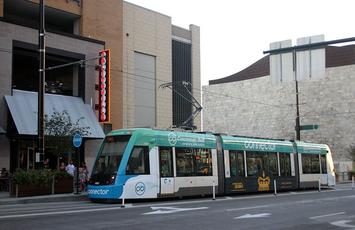
The Cincinnati streetcar–now known as the Cincinnati Bell Connector since Cincinnati Bell paid $3.4 million for naming rights–is barely six months old, and already is having problems. Four streetcars broke down in one day a few months ago.
Now the company that is contracted to operate the streetcar has warned that poor quality control by the railcar maker has resulted in “catastrophic failures” of three different major systems that cause regular breakdowns of the vehicles. Cincinnati Bell is upset enough to demand possibly illegal secret meetings with the city council over the streetcar’s problems.
Cincinnati once counted itself lucky that it didn’t order streetcars from United Streetcar, the short-lived company that made streetcars for Portland and Tucson, many of which suffered severe manufacturing defects. But it turns out the vehicles it ordered from a Spanish company named Construcciones y Auxiliar de Ferrocarriles (CAF), which were delivered 15 months late, weren’t much better.
The streetcar is routed through, and is supposed to revitalize, Cincinnati’s Over-the-Rhine district, a former low-income neighborhood near downtown. But that neighborhood was already revitalizing long before the streetcar opened. No doubt someone will credit the revitalization to the streetcar, but in fact it was due to millions of dollars in taxpayer subsidies.
Many of those subsidies come from tax-increment financing (TIF). Cincinnati has liberally created dozens of TIF districts (a state law limiting TIF districts to 300 acres forced the city to create two for Over-the-Rhine, which is districts 3 & 4). The city encourages developers to simply apply for funds, effectively allowing them to use the money they would have paid in property taxes to help finance their development.
Naturally, developers love it. Just like the streetcar, however, TIF is a raw deal for taxpayers who end up having to pay higher taxes, or receive a lower level of urban services, in order to provide services to the TIF districts that should have been funded out of the taxes paid by property owners in that district.
This piece first appeared on The Antiplanner.
Randal O’Toole is a senior fellow with the Cato Institute specializing in land use and transportation policy. He has written several books demonstrating the futility of government planning. Prior to working for Cato, he taught environmental economics at Yale, UC Berkeley, and Utah State University.
Photo by RickDikeman (Own work) [CC0], via Wikimedia Commons













Not much better luck in Washington, D.C. with CAF
But it turns out the vehicles it ordered from a Spanish company named Construcciones y Auxiliar de Ferrocarriles (CAF), which were delivered 15 months late, weren’t much better.
WMATA purchased its so-called "5000-series" railcars from CAF and took delivery in the period between 2000 and 2005. They have had a lot of reliability problems (including derailments), and there are plans to send them all to the junkyard instead of doing a so-called "mid-life overhaul," and replace them with railcars built by Kawasaki in Nebraska.